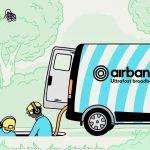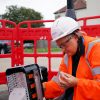SPL to Trial UK Airborne 5G Mobile via BN2T-4S Islander Aircraft

Stratospheric Platforms (SPL) and BT (EE) revealed earlier this year that they were developing a UK trial to harness High-Altitude Platform Station (HAPS) aircraft to help extend 5G (mobile broadband) coverage into remote rural areas (here). SPL now intends to trial similar technology, during 2024, aboard a Britten-Norman Islander aircraft.
The idea of using unmanned aerial vehicles (UAVs) to deliver a 4G or 5G mobile signal is nothing new, although in the past operators have tended to only adopt the limited use of drones and air balloons (blimps) for providing temporary connectivity (here) solutions to remote communities over a restricted area of coverage (e.g. during disasters, network outages or to help emergency services).
The goal of SPL’s project is to go much further by delivering an unmanned, liquid hydrogen-powered aircraft, designed with a 56-metre wingspan that will, due to its lightweight structure and significant power source, enable a flight endurance of over a week and covering a much wider area from the stratosphere.
Advertisement
As part of this work SPL has now won a significant contract, which will see them trialling advanced airborne 5G connectivity from a Britten-Norman Islander. Aircraft manufacturer Britten-Norman will be providing key design and trials support for the project, with Marshall Futureworx providing important cooling systems technology.
According to SPL’s earlier reports, the new antenna they’ll be using can provide uninterrupted 4G and 5G connectivity direct to consumer smartphones. The phased array antenna is capable of delivering faster speeds, in some cases “up to 150Mbps” across areas as “wide as 140km or 15,000 square km” (an area equivalent to the average footprint of 450 terrestrial masts), through 500 individually steerable beams. But it’s unclear if this reflects shared capacity between many users.
Kevin Bean, CTO at SPL, said:
“We are delighted to be working with Britten-Norman on this programme. The Islander is a great workhorse for this kind of engineering because it can be rapidly and extensively modified to accommodate our equipment.
The role-based type of mission which can readily be executed by the Islander, combined with the stability of the platform, is ideal for a programme where telecommunication trials require predictable performance.”
The first phase of the new contract will see SPLs 5G airborne phased array integrated to a Britten-Norman Islander, with flight trials due to begin in July 2024. The turbine-powered BN2T-4S Islander variant has been selected for the programme due to its performance and payload capacity and the simplicity with which it can be modified to accommodate the equipment. The trial will be conducted under Britten-Norman’s Civil Aviation Authority test conditions.
Britten-Norman will operate the aircraft from its Solent Airport aircraft maintenance (MRO) facility, with the mission to be performed over the North Sea. The 5G phased array will be linked via a backhaul link to the Adastral Tower in Suffolk, England, from which the telecommunications and mission equipment will operate.
Advertisement
The move toward a live field trial reflects an important step forward in the project, although it’s worth noting that such approaches seem likely to come under growing pressure from the new generation of satellites in Low Early Orbit (e.g. Starlink, AST Space Mobile etc.). Some of those are also touting their ability to connect directly, via 4G and 5G, to regular Smartphones.
Mark is a professional technology writer, IT consultant and computer engineer from Dorset (England), he also founded ISPreview in 1999 and enjoys analysing the latest telecoms and broadband developments. Find me on X (Twitter), Mastodon, Facebook, BlueSky, Threads.net and Linkedin.
« O2 UK Launch FREE Crafty Lager 7726 with Ross Kemp to Tackle Scams
Go Fibre and Upp Adopt New UK Full Fibre Street Cabinets »























































Missing an “e” on the title? 🙂
Corrected, thanks.
This seems to me as a layman as a very expensive way to give mobile coverage to a handful of people that will surely never be profitable. I don’t see the point unless it’s an exercise in “look what we could do”. A balloon would be much cheaper. A satellite might even work out cheaper in the long-run. Or just spend the money and build the infrastructure. I see stories like this as just a distraction and a bit of fun. It’s not a serious thing, and most likely the company behind it will cease to exist in 3-4 years.
A balloon would drift away, tethering at those altitudes is not practical but yes, I agree.
Is it April already!
Oh yeas here’s your 5G, that’s £300 a month Thankyou!
Is it ‘H A P S’ or ‘H A P L E S S’ ? 🙂
Another case of a ‘can we do it project’ where nobody asked ‘should we do it’ or why ?